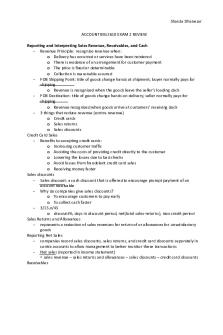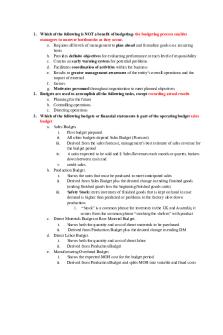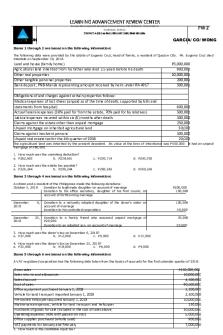Accounting 2- Review - Professor Jim Resnik PDF

| Title | Accounting 2- Review - Professor Jim Resnik |
|---|---|
| Course | Accounting Principles II |
| Institution | Yeshiva University |
| Pages | 12 |
| File Size | 874.7 KB |
| File Type | |
| Total Downloads | 100 |
| Total Views | 136 |
Summary
Professor Jim Resnik...
Description
Review 1) Income Statement 2) Owner’s Equity Statement 3) Balance Sheet 4) Statement of Cash Flows 1)Income Statement: •Reports the revenues and expenses for a specific period of time. •Lists revenues first, followed by expenses. •Shows net income (or net loss). •Does not include investment and withdrawal transactions between the owner and the business in measuring net income. These were the sales, this was the expenses, this is the difference. Tells either net income or net loss 2)Owner’s Equity Statement: •Reports the changes in owner’s equity for a specific period of time. •The time period is the same as that covered by the income statement. What happens with the profit will be told to you in this statement. Owner’s Equity- Two parts: Owner’s Investment, Retained Earning If some other owner comes in and adds more money that affects it and if they earn a profit and leave it in there, that also affects it 3)Balance Sheet: •Reports the assets, liabilities, and owner's equity at a specific date. •Lists assets at the top, followed by liabilities and owner’s equity. •Total assets must equal total liabilities and owner's equity. •Is a snapshot of the company’s financial condition at a specific moment in time (usually the month-end or year-end). Assets- Money, Truck, Airplane, Insurance Liabilities- Obligations to pay money 4)Statement of Cash Flows: •Information on the cash receipts and payments for a specific period of time. •Answers the following: Where did cash come from? What was cash used for? What was the change in the cash balance?
This is the order of how companies will prepare the statements
Basic Accounting Equation Assets= Liabilities Owner’s Equity Assets: Resources owned (physical resources and rights) Liabilities: Obligations (to pay, deliver, do) Owner’s Equity: Investments by owners (out-of-pocket and reinvested profits) External Transaction: Buy a truck, increase asset Internal Transaction: Devalue worth of truck over time
2. TRANSACTION 2. PURCHASE OF EQUIPMENT FOR CASH Softbyte Inc.
purchases computer equipment for $7,000 cash.
1. +15,000
+15,000
2.
-7,000
+7,000
TRANSACTION 3. PURCHASE OF SUPPLIES ON CREDIT Softbyte Inc. purchases for $1,600 headsets and other accessories expected to last several months. The supplier allows Softbyte to pay this bill in October.
1. 2. 3.
+15,000 -7,000
+15,000 +7,000 +$1,600
+$1,600
TRANSACTION 4. SERVICES PERFORMED FOR CASH Softbyte Inc. receives $1,200 cash from customers for app development services it has performed.
1. 2. 3. 4.
+15,000 -7,000
+15,000 +7,000 +$1,600
+$1,200
+$1,600 +$1,200
TRANSACTION 5. PURCHASE OF ADVERTISING ON CREDIT Softbyte Inc. receives a bill for $250 from the Daily News for advertising on its online website but postpones payment until a later date.
1. +15,000 +15,000 2. -7,000 +7,000 3. +$1,600 +$1,600 4. +$1,200 +$1,200 5. +$250 -$250 See https://docs.google.com/document/d/1dFeA451Hi7CJn6I6lCK346_qeWagVI-
arnJ9J3oMFG4/edit for the rest Luca Pacioli- First guy to write up double entry accounting
Do numbers on the left equal the numbers on the right 3,000+7,000=10,000
Profits= Revenues-Expenses Owner’s Capital= Owner’s Investments Owner’s Drawings= What owner takes out
Owner’s Capital and Positive Net Income increases Owner’s Equity More of an Expense is a less of Owner’s Equity Debit Expense is reducing Owner’s Equity Debit Revenue is increasing Owner’s Equity General Journal- Recording everything in chronological Transfer it into General Ledger One page per account (Cash, Accounts Receivable, Equipment)
Illustration: On September 1, Ray Neal invested $15,000 cash in the business, and Softbyte purchased computer equipment for $7,000 cash.
First Debit Cash 15,000 and then Credit Owner’s Capital 15,000 (Because adding 15,000 to Owner’s Capital) Second debit equipment 7000 then credit cash 7000
Posting- Moving from Journal to ledger
Put in correct catergory. Write date and reason and amount
Accrual-Basis Accounting Transactions recorded in the periods in which the events occur. Companies recognize revenues when they perform services (rather than when they receive cash). Expenses are recognized when incurred (rather than when paid). In accordance with generally accepted accounting principles (GAAP). Adjusting Entries Ensure that the revenue recognition and expense recognition principles are followed. Necessary because the trial balance may not contain up-to-date and complete data. Required every time a company prepares financial statements. Will include one income statement account and one balance sheet account. Revenues-Expenses=Net Income Recording a Contingent Liability Product Warranties: •Promise made by a seller to a buyer to make good on a deficiency of quantity, quality, or performance in a product. •Estimated cost of honoring product warranty contracts should be recognized as an expense in the period in which the sale occurs. Illustration: Denson Manufacturing Company sells 10,000 washers and dryers at an average price of $600 each. The selling price includes a one-year warranty on parts. Denson expects
that 500 units (5%) will be defective and that warranty repair costs will average $80 per unit. In 2012, the company honors warranty contracts on 300 units, at a total cost of $24,000. At December 31, compute the estimated warranty liability.
10,000 (Number of Units) X 5% (Estimate rate of Defective Units = 500 (Total Estimated Defective Units) 500 X 80 (Average Warranty Repair Cost) = $40,000 (Estimated Product Warranty Liability Warranty Expense 40,000 Warranty Liability 40,000 Warranty Liability account goes into the next year and slowly goes down (it’s a credit account so debited to go down). You already took the expense by estimating warranty cost. The liability is just an estimate. Illustration: Prepare the entry to record the repair costs incurred in 2012 to honor warranty contracts on 2012 sales. Warranty Liability 24,000 Repair Parts 24,000 So liability went down 24,000 Illustration: Assume that the company replaces 20 defective units in January 2013, at an average cost of $80 in parts and labor. 20X80= 1600 Warranty Liability 1,600 Repair parts 1,600 Ex: Year 1 sell 100,0000 Year 2 sell 200000 Year 3 sell 300000 Warranty Liability 10000 (estimated 10% year 1) 8000 (only actually had this)
Year 1: 2000 (extra carries over to next year) 20000 (estimated 10% year 2) 15000 7000 (20k+2k-15k=7000 extra that carries over to next year, now is probably the time to adjust percentage of warranty costs)
“Payroll” pertains to both: Salaries - managerial, administrative, and sales personnel (monthly or yearly rate). Wages - store clerks, factory employees, and manual laborers (rate per hour). Determining the Payroll: Involves computing three amounts: (1) gross earnings, (2) payroll deductions, and (3) net pay. 1) Gross Earnings: Total compensation earned by an employee (wages or salaries, plus any bonuses and commissions). Here getting paid for ovetime
2) Payroll Deductions Mandatory: FICA tax (Social Security taxes Supplemental retirement, employment disability, and medical benefits) Federal income tax, State income tax Voluntary: Charity, Insurance, Union dues, Pension plans 3) Net Pay
Maintaining Payroll Department Records: An employer must keep a cumulative record of each employee’s gross earnings, deductions, and net pay during the year. Recognizing Payroll Expenses and Liabilities Salaries and Wages Expense 17,210.00 FICA Tax Payable 1,376.80 Federal Income Tax Payable 3,490.00 State Income Tax Payable 344.20 Union Wages Payable 421.50 Union dues payable 115.00 Salaries and wages payable 11,462.50 Illustration: Prepare the entry Academy Company would make to record the payroll for the week ending January 14. Salaries and wages payable 11,462.50 Cash 11,462.50 The rest of the money goes to those payable Employer Payroll Taxes- Payroll tax expense results from three taxes that governmental agencies levy on employers. Illustration: (using above data) Academy records the payroll tax expense associated with the January 14 payroll with the following entry. Use the following rates: FICA 8%, state unemployment 5.4%, federal unemployment 0.8%. 17,210X8%=1,376.80 (FICA) 17,210Xx 5.4%=929.34 (State) 17,210x.8%=137.68 (Federal) 1376.80+929.24+137.68=2,443.82 (Total) Payroll Tax Expense 2,443.82 FICA Tax Payable State Unemployement Tax Payable Federal Unemployement Tax Payable
1376.80 929.24 137.68
Filing and Remitting Payroll Taxes: Companies must report FICA taxes and federal income taxes withheld no later than one month following the close of each quarter. Companies generally file and remit federal unemployment taxes annually on or before January 31 of the subsequent year. Companies usually file and pay state unemployment taxes by the end of the month following each quarter. Employers must provide each employee with a Wage and Tax Statement (Form W-2) by January 31.
Internal Control for Payroll: As applied to payroll, the objectives of internal control are 1) to safeguard company assets against unauthorized payments of payrolls, and 2) to ensure the accuracy and reliability of the accounting records pertaining to payrolls....
Similar Free PDFs

Accounting Exam 2 Review
- 10 Pages

Accounting Exam 2 Review
- 17 Pages

Accounting Exam 2 Review
- 8 Pages

Accounting review
- 13 Pages

Accounting 1 Exam 2 Review notes
- 21 Pages

Review #21 - Accounting 002
- 6 Pages

Review for Financial Accounting
- 35 Pages

Accounting 1 Review
- 4 Pages

Review #22 - Accounting 002
- 5 Pages

Accounting Final Review
- 9 Pages

Accounting Exam 1 Review
- 3 Pages
Popular Institutions
- Tinajero National High School - Annex
- Politeknik Caltex Riau
- Yokohama City University
- SGT University
- University of Al-Qadisiyah
- Divine Word College of Vigan
- Techniek College Rotterdam
- Universidade de Santiago
- Universiti Teknologi MARA Cawangan Johor Kampus Pasir Gudang
- Poltekkes Kemenkes Yogyakarta
- Baguio City National High School
- Colegio san marcos
- preparatoria uno
- Centro de Bachillerato Tecnológico Industrial y de Servicios No. 107
- Dalian Maritime University
- Quang Trung Secondary School
- Colegio Tecnológico en Informática
- Corporación Regional de Educación Superior
- Grupo CEDVA
- Dar Al Uloom University
- Centro de Estudios Preuniversitarios de la Universidad Nacional de Ingeniería
- 上智大学
- Aakash International School, Nuna Majara
- San Felipe Neri Catholic School
- Kang Chiao International School - New Taipei City
- Misamis Occidental National High School
- Institución Educativa Escuela Normal Juan Ladrilleros
- Kolehiyo ng Pantukan
- Batanes State College
- Instituto Continental
- Sekolah Menengah Kejuruan Kesehatan Kaltara (Tarakan)
- Colegio de La Inmaculada Concepcion - Cebu




